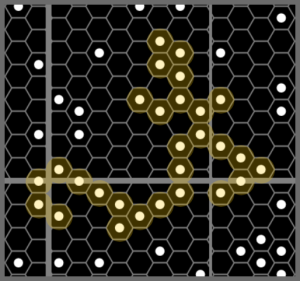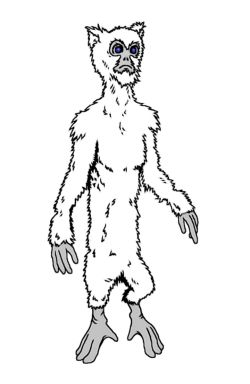Lighoz Subsector
| Lighoz Subsector | ||||||
|---|---|---|---|---|---|---|
| ||||||
| Sector | Provence | |||||
| Capital | None | |||||
| No. of Stars | 28 | |||||
| Majority Control | Dzarrgh Federate - 61% | |||||
| 2nd Control | Irrgh Manifest - 39% | |||||
Lighoz Subsector is Subsector M of Provence Sector.
- It lies within Charted Space.
- It is part of the Vargr Extents.
Description / Specifications[edit]
Lighoz Subsector is a region that has seen millennia of settlement by Vargr.
- The resources of the subsector are being exploited.
Astrographic Features & Trade Routes[edit]
The following astrographic and commercial data has been determined regarding Lighoz Subsector:
- The subsector is an average stellar density region.
- The brightest star is the white bright giant primary of the Aeghzisung system.
- The Dzarrgh Run, an important local trade route, passes through the subsector.
Stellar Distribution[edit]
A basic map showing the distribution and size of stars within Lighoz Subsector.
- The color corresponds to the visible color of the star, which links to its spectral classification.
- The size as shown indicates both the physical size of the object and its relative brightness.

(Chart sourced from Traveller Map).
Note that the stars as depicted are representative. Any star, no matter what its size, is a mere speck within the hex it occupies.
- Ordinary main sequence stars can barely be seen from even a hex away.
- Huge, intensely luminous giant stars can be seen from across the subsector and far beyond.
The Dzarrgh Run[edit]
The rimward worlds of the subsector are members of the Dzarrgh Run, a trade route running between Provence Sector and Corridor Sector. It is a small Main.
- It has 28 member systems.
- A few of its coreward worlds lie within the Irrgh Manifest, a Vargr polity.
- Its central worlds run through Balkanized Space and the Imperium.
- Some of its spinward worlds are members of the Dzarrgh Federate, a Vargr polity.

(Chart sourced from Traveller Map)
- Worlds lying on the Run are highlighted in tan.
World Listings[edit]
Comprehensive Second Survey UWP data for all worlds lying within the subsector is available.
- The primary source material for all data is Traveller Map.
- Other sources may contain contradictory or incorrect information.
Note that some Second Survey data, though only 40 years old, is likely to be out of date.
- Data is occasionally updated as new information becomes available.
- Scouting missions gathering reliable, verified data can receive substantial payment.
- Verified updated data is constantly sought.
History & Background (Dossier)[edit]
The large number of planetoid belts located within the habitable zones of stars (including Dzaegkaek, Anthonkfoers, Aenggvug, Gingrue, Aeghzisung, and Orgukung within Voudzeur Subsector) has led Vargr researchers to conclude that these worlds were once whole. They believe that these worlds were destroyed during the War of the Ancients. Although there is plenty of circumstantial evidence to support the theory, conclusive evidence has not yet been found.
- Small teams of Vargr researchers, funded by shadowy interests, operate from bases within the belts.
Polity Listing[edit]
The following polities lie within the subsector:
- Irrgh Manifest (VIrM).
- Dzarrgh Federate (VDzF).
Native Sophonts (NILs)[edit]
No races (sophont species) are believed to have originated in this area.
Demographics[edit]
Significant populations of the following races (sophont species) reside within this area:
- Terragens (Non-human Terran races)
- Humaniti (Human Races)
- Mixed heritage (Major Race): sparsely distributed across the sector.
- Solomani (Major Race): sparsely distributed across the sector.
- Non-Human Races
- Aezorgh of Soghzalghag: native to Windhorn Sector and sparsely distributed across the rimward parts of the Vargr Extents.
- Dhaen of Dhaen: small, long-bodied, pale furred humanoids not recognized by the Vargr as being sophont.
Major Historical Events Timeline[edit]
Major events that have affected this subsector and the wider region that it lies within:
- ca -250,000: The Ancients were active within the sector, transplanting the Vargr onto Lair.
- -9235: the Vilani discover jump technology. A few explorers and settlers begin to pioneer the region.
- -4045 to -2204: the Ziru Sirka claims a few rimward worlds and establishes a firm border. The Windhorn Rift and the absence of any significant Mains discourages large-scale Vilani expansion into the region.
- -3810: the Vargr discover jump technology and begin an era of expansion.
- -2404 to -2215: the human Interstellar Wars rage far to rimward. The region becomes increasingly neglected.
- -2400s: Vargr raiding into human-dominated areas significantly increases. This becomes known as the Vargr Pillaging.
- ca -2350: the Foergaz Coalition, an early polity, collapses.
- -2204 to -1776: the Rule of Man nominally administers the rimward worlds of the region. Conflicts escalate between Vargr and humans as the Vargr occupy former Ziru Sirka territory.
- ca -1700: Vargr rimward expansion gradually ceases: the border between human and Vargr space stabilizes.
- -1776 to 0: the Long Night. There is widespread regression within the area and some worlds become barren.
- The Year 0: to rimward-trailing, the Third Imperium is founded.
- circa 26: the Empire of Varroerth is founded.
- early 100s: the Contract of Taarskoerzn is founded.
- 300-420: the Imperial First Survey charts the subsector.
- early 400s: the Irrgh Manifest is founded: it absorbs the Contract of Taarskoerzn.
- mid 500s: the Knokseng Confederation is founded.
- 777: the Lair Protectorate is established.
- 869: the Glory of Taarskoerzn is founded. It splits the Irrgh Manifest.
- 995-1065: the Imperial Second Survey charts the subsector.
- 1065: the Second Survey is published. Information about the subsector becomes widely available.
- 1080s: the Knokseng Confederation is dissolved.
- 1090: the Dzarrgh Federate is formed.
Subsector Summary[edit]
Lighoz, subsector M of Provence contains 28 worlds with an estimated population of 74 billion, a per capita income of Cr3,783, and a total economy is BCr280,761. These worlds originate an interstellar trade of BCr1,157 through 28 starports (6 Class A, 12 Class B, 8 Class C, 2 Class D) employing 166,015 people. Driving this interstellar trade are four Agricultural (Ag) worlds, one Non-Agricultural (Na) world, no Pre-Agricultural (Pa) worlds, one Pre-Industrial (Pi) world, three Rich (Ri) worlds, and no Industrial (In) worlds. The governments in Lighoz maintain 11 Naval bases, seven Corsair bases, and two Military bases. The average technology level is 9 (with most between 8 and 11). The highest technology level is 13 at Uedtzon (Provence 0635) and Kirg (Provence 0831).
Lighoz, subsector M of Provence contains 35 stars and 320 identified planets; 21 monostellar systems, seven binary systems, no trinary systems, and no systems with four or more stars. 28 of the 28 systems (100%) have native gas giants. There are one Asteroid (As) belt, no Desert (De) worlds, one Garden (Ga) world, one Ice-capped (Ic) world, one Poor (Po) world, four Vacuum (Va) worlds, and two Water (Wa) or Ocean (Oc) worlds.
Lighoz has an estimated population of 74 billion distributed across four High population (Hi) worlds, no Moderate population (Ph) worlds, 12 Non-industrial (Ni) worlds, seven Low population (Lo) worlds, and no Barren (Ba) worlds. The highest population world is Arerzthoe (Provence 0634). The population consists of 1 sophont groups.
| 1 identified sophont populations in Lighoz | |
|---|---|
Dzarrgh Federate[edit]
The Dzarrgh Federate has jurisdiction over 17 worlds with an estimated population of 7 billion, a per capita income of Cr5,854, and a total economy is BCr42,036. These worlds originate an interstellar trade of BCr509 through 17 starports (4 Class A, 5 Class B, 6 Class C, 2 Class D) employing 82,125 people. Driving this interstellar trade are three Agricultural (Ag) worlds, one Non-Agricultural (Na) world, no Pre-Agricultural (Pa) worlds, one Pre-Industrial (Pi) world, two Rich (Ri) worlds, and no Industrial (In) worlds. The governments in Dzarrgh Federate maintain six Naval bases, four Corsair bases, and one Military base. The average technology level is 9 (with most between 7 and 11). The highest technology level is 13 at Kirg (Provence 0831).
The Dzarrgh Federate has an estimated population of 7 billion distributed across one High population (Hi) world, no Moderate population (Ph) worlds, five Non-industrial (Ni) worlds, six Low population (Lo) worlds, and no Barren (Ba) worlds. The highest population world is Lighoz (Provence 0335). The population consists of 1 sophont groups.
Irrgh Manifest[edit]
The Irrgh Manifest has jurisdiction over 11 worlds with an estimated population of 67 billion, a per capita income of Cr3,561, and a total economy is BCr238,725. These worlds originate an interstellar trade of BCr647 through 11 starports (2 Class A, 7 Class B, 2 Class C, 0 Class D) employing 83,890 people. Driving this interstellar trade are one Agricultural (Ag) world, no Non-Agricultural (Na) worlds, no Pre-Agricultural (Pa) worlds, no Pre-Industrial (Pi) worlds, one Rich (Ri) world, and no Industrial (In) worlds. The governments in Irrgh Manifest maintain five Naval bases, three Corsair bases, and one Military base. The average technology level is 10 (with most between 9 and 11). The highest technology level is 13 at Uedtzon (Provence 0635).
The Irrgh Manifest has an estimated population of 67 billion distributed across three High population (Hi) worlds, no Moderate population (Ph) worlds, seven Non-industrial (Ni) worlds, one Low population (Lo) world, and no Barren (Ba) worlds. The highest population world is Arerzthoe (Provence 0634). The population consists of 1 sophont groups.
References & Contributors (Sources)[edit]
| This article is missing content for one or more detailed sections. Additional details are required to complete the article. You can help the Traveller Wiki by expanding it. |
- J. Andrew Keith, Marc Miller, John Harshman. Vargr (Game Designers Workshop, 1984), IBC. (Subsector located but no world data provided)
- James Holden, Joe D. Fugate Sr., Terrance McInnes. Vilani & Vargr (Digest Group Publications, 1990), pages 11, 48, 49. (Dot maps indicating the location of worlds within the subsector, and charts indicating political allegiances)
- James Holden. Article Snapshots of the Occupation. (Periodical: MegaTraveller Journal 2, 1991), page 52. (Background for Provence Sector)
- Simon Beal. Vargr (Mongoose Publishing, 2009), various pages. (Background for the Windhorn Rift region)
- External Link: Traveller in the DED Zone (Golden Age and New Era subsector details)
- Author & Contributor: David Drazul. (Generated data)

